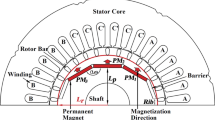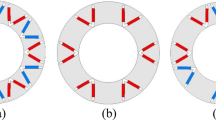Abstract
The breakthroughs in permanent magnet synchronous machines through the latest technologies, especially about machine design, raise the importance of those machines. Moreover, developments in materials technology implement the development of cost effective and profitable products on electric machines. Permanent magnet synchronous machines are divided into two parts according to the situation of slot/pole combination, which is integer or fractional. Permanent magnet synchronous machines are subject of interest due to low torque ripple and low cogging torque. In this paper, the 2D lumped parameter method (LPM) of permanent magnet synchronous machine was composed and stated, and lumped parameter was verified by finite element method. When SMC materials are used in electric machines, flux flows in 3D. Because of this and according to literatures, 3D method is used to analyze the SMC-used machines. 3D finite element method takes a quite long time. Thanks to 2D LPM analysis, which was used in our work; the analysis period become remarkably shorter. In addition, torque and back EMF of permanent magnet synchronous machine were calculated through the developed LPM method. Prototype is tested. It is seen by the results that the produced prototype and the developed algorithm are matching properly.

























Similar content being viewed by others
References
Shokrollahi H, Janghorban K (2007) Soft magnetic composite materials (SMCs). J Mater Process Technol 189(1–3):1–12. ISSN 0924-0136
Bianchi N, Bolognani S, Grezzani G (2006) Design considerations for fractional-slot winding configurations of synchronous machines. IEEE Trans Ind Appl 42(4):997–1006
Slemon GR (1953) Equivalent circuits for transformers and machines including non-linear effects. Proc IEEE 100:129–143
Fiennes J (1973) New approach to general theory of electrical machines using magnetic equivalent circuits. Proc IEEE 120:94–104
Ostovic VA (1986) method for evaluation of transient and steady state performance in saturated squirrel cage induction machines. IEEE Trans Energy Convers EC–1:190–197
Laithwaite ER (1967) Magnetic equivalent circuits for electrical. Proc IEEE 114:1805–1809
Carpenter CJ (1968) Magnetic equivalent circuits. Proc IEEE 115:1503–1511
Slemon GR (1990) An equivalent circuit approach to analysis of synchronous machines with saliency and saturation. IEEE Trans Energy Convers 5:538–545
Shima K, Ide K, Takahashi M, Oka K (2003) Steady-state magnetic circuit analysis of salient-pole synchronous machines considering cross-magnetization. IEEE Trans Energy Convers 18:213–218
Qin R, Rahman MA (2003) Magnetic equivalent circuit of PM hysteresis synchronous motor. IEEE Trans Magn 39:2998–3000
Delale A, Albert L, Gerbaud L, Wurtz F (2004) Automatic generation of sizing models for the optimization of electromagnetic devices using reluctance networks. IEEE Trans Magn 40:830–833
du Peloux B, Gerbaud L, Wurtz F, Leconte V, Dorschner F (2006) Automatic generation of sizing static models based on reluctance networks for the optimization of electromagnetic devices. IEEE Trans Magn 42:715–718
Hwang CC, Cho YH (2001) Effects of flux leakage on magnetic fields of interior permanent magnet synchronous motors. IEEE Trans Magn 37:3021–3025
Tsai WB, Chang TY (2001) Analysis of flux leakage in a brushless permanent-magnet motor with embedded magnets. IEEE Trans Magn 35:543–547
Qu R, Lipo TA (2004) Analysis and modeling of air-gap and zigzag flux leakagees in a surface-mounted permanent magnet machine. IEEE Trans Ind Appl 40:121–127
Zheng L, Wu TX, Sundaram KB, Vaidya J, Zhao L, Acharya D, Ham CH, Kapat J, Chow L (2005) Analysis and test of a high-speed axial flux permanent magnet synchronous motor. In: Proceeding of international electric machines and drives conference (IEMDC), San Antonio, TX, USA, pp 119–124, 15–18 May 2005
Vaez-Zadeh S, Isfahani AH (2007) Enhanced modeling of linear permanent-magnet synchronous motors. IEEE Trans Magn 43:33–39
Zhu J, ve Guo Y (2004) Study with magnetic property measurement of soft magnetic composite material and its application in electrical machines. IEEE industrials application conference, 3–7 Oct. 2004
Maeda T, Toyoda H, Igarashi N, Hirose K, Mimura K, Nishioka T, Ve IA (2005) Development of super low iron-loss P/M soft magnetic material. SEI Tech Rev 60:3–9
Hultman LO, ve Jack AG (2003) Soft magnetic composites—materials and applications. IEEE international electric machines and drives conference, IEMDC’03, pp 516–522, Madison, USA, 1–4 June 2003
Qian J, Chen X, Chen H, Zeng L, Li X (2013) Magnetic field analysis of Lorentz motors using a novel segmented magnetic equivalent circuit method. Sensors 13:1664–1678
VuXuan H, Lahaye D, Ani SO, Polinder H, Ferreira JA (2011) Effect of design parameters on electromagnetic torque of PM machines with concentrated windings using nonlinear dynamic FEM. IEEE international electric machines & drives conference (IEMDC’11), pp 383–388, Niagara Falls, ON, 15–18 May 2011
Author information
Authors and Affiliations
Corresponding author
Rights and permissions
About this article
Cite this article
Oner, Y., Şenol, İ. Lumped parameter method of permanent magnet synchronous generator for wind energy. Electr Eng 98, 169–177 (2016). https://doi.org/10.1007/s00202-015-0354-1
Received:
Accepted:
Published:
Issue Date:
DOI: https://doi.org/10.1007/s00202-015-0354-1




